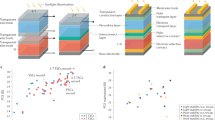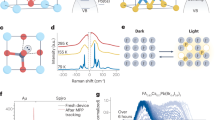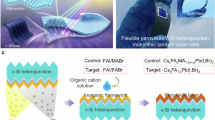Abstract
Perovskite/silicon tandem solar cells (TSCs) have emerged as a promising technology for photovoltaic energy harvesting and have already exceeded the limits of traditional single-junction solar cells. Despite recent power conversion efficiency values nearing 35%, perovskite/silicon TSCs still exhibit a considerable efficiency deficit relative to their theoretical upper limit. Scientific and technological challenges related to the long-term operational stability and scalability must also be addressed for this technology to be commercialized. This Review provides an overview of state-of-the-art perovskite/silicon TSCs with particular attention to three key areas: efficiency, stability and scalability. The Review concludes with a critical overview of the remaining challenges and future perspectives for the further development of this technology.
This is a preview of subscription content, access via your institution
Access options
Access Nature and 54 other Nature Portfolio journals
Get Nature+, our best-value online-access subscription
$32.99 / 30 days
cancel any time
Subscribe to this journal
Receive 12 print issues and online access
$259.00 per year
only $21.58 per issue
Buy this article
- Purchase on SpringerLink
- Instant access to full article PDF
Prices may be subject to local taxes which are calculated during checkout




Similar content being viewed by others
References
Chen, H. et al. Improved charge extraction in inverted perovskite solar cells with dual-site-binding ligands. Science 384, 189–193 (2024).
Liu, S. et al. Buried interface molecular hybrid for inverted perovskite solar cells. Nature 632, 536–542 (2024).
Ehrler, B. et al. Photovoltaics reaching for the Shockley–Queisser limit. ACS Energy Lett. 5, 3029–3033 (2020).
Yamaguchi, M., Dimroth, F., Geisz, J. F. & Ekins-Daukes, N. J. Multi-junction solar cells paving the way for super high-efficiency. J. Appl. Phys. 129, 240901 (2021).
Geisz, J. F. et al. Multi-junction solar cells paving the metamorphic concentrator solar cell. IEEE J. Photovolt. 8, 626–632 (2018).
France, R. M. et al. Triple-junction solar cells with 39.5% terrestrial and 34.2% space efficiency enabled by thick quantum well superlattices. Joule 6, 1121–1135 (2022).
Zheng, J. et al. Large area efficient interface layer free monolithic perovskite/homo-junction-silicon tandem solar cell with over 20% efficiency. Energy Environ. Sci. 11, 2432–2443 (2018).
Green, M. A. et al. Solar cell efficiency tables (version 66). Prog. Photovolt. Res. Appl. https://doi.org/10.1002/pip.3919 (2025).
Steiner, M. A. et al. High efficiency inverted gaas and GaInP/GaAs solar cells with strain-balanced GaInAs/GaAsP quantum wells. Adv. Energy Mater. 11, 2002874 (2021).
Fu, F. et al. Monolithic perovskite–silicon tandem solar cells: from the lab to fab? Adv. Mater. 34, 2106540 (2022).
Ying, Z., Yang, X., Wang, X. & Ye, J. Towards the 10-year milestone of monolithic perovskite/silicon tandem solar cells. Adv. Mater. 36, 2311501 (2024).
Aydin, E. et al. Pathways toward commercial perovskite/silicon tandem photovoltaics. Science 383, eadh3849 (2024).
Chi, W., Banerjee, S. K., Jayawardena, K. G. D. I., Silva, S. R. P. & Seok, S. I. Perovskite/silicon tandem solar cells: choice of bottom devices and recombination layers. ACS Energy Lett. 8, 1535–1550 (2023).
Duan, L. et al. Stability challenges for the commercialization of perovskite–silicon tandem solar cells. Nat. Rev. Mater. 8, 261–281 (2023).
Gota, F., Langenhorst, M., Schmager, R., Lehr, J. & Paetzold, U. W. Energy yield advantages of three-terminal perovskite–silicon tandem photovoltaics. Joule 4, 2387–2403 (2020).
De Bastiani, M. et al. Efficient bifacial monolithic perovskite/silicon tandem solar cells via bandgap engineering. Nat. Energy 6, 167–175 (2021).
Dai, L. et al. Three-terminal monolithic perovskite/silicon tandem solar cell exceeding 29% power conversion efficiency. ACS Energy Lett. 8, 3839–3842 (2023).
Fang, Z. et al. Surface reconstruction of wide-bandgap perovskites enables efficient perovskite/silicon tandem solar cells. Nat. Commun. 15, 10554 (2024).
Futscher, M. H. & Ehrler, B. Efficiency limit of perovskite/Si tandem solar cells. ACS Energy Lett. 1, 863–868 (2016).
Hou, F. et al. Monolithic perovskite/silicon tandem solar cells: a review of the present status and solutions toward commercial application. Nano Energy 124, 109476 (2024).
Werner, J. et al. Efficient monolithic perovskite/silicon tandem solar cell with cell area >1 cm2. J. Phys. Chem. Lett. 7, 161–166 (2016).
Chen, B. et al. Insights into the development of monolithic perovskite/silicon tandem solar cells. Adv. Energy Mater. 12, 2003628 (2021).
Jošt, M. et al. Textured interfaces in monolithic perovskite/silicon tandem solar cells: advanced light management for improved efficiency and energy yield. Energy Environ. Sci. 11, 3511–3523 (2018).
Schneider, B. W., Lal, N. N., Baker-Finch, S. & White, T. P. Pyramidal surface textures for light trapping and antireflection in perovskite-on-silicon tandem solar cells. Opt. Express 22, A1422–A1430 (2014).
Kanda, H. et al. Effect of silicon surface for perovskite/silicon tandem solar cells: flat or textured? ACS Appl. Mater. Interfaces 10, 35016–35024 (2018).
Khan, D., Qu, G., Muhammad, I., Tang, Z. & Xu, Z.-X. Overcoming two key challenges in monolithic perovskite–silicon tandem solar cell development: wide bandgap and textured substrate—a comprehensive review. Adv. Energy Mater. 13, 2302124 (2023).
Bush, K. A. et al. Thermal and environmental stability of semi-transparent perovskite solar cells for tandems enabled by a solution-processed nanoparticle buffer layer and sputtered ITO electrode. Adv. Mater. 28, 3937–3943 (2016).
Fu, F. et al. High-efficiency inverted semi-transparent planar perovskite solar cells in substrate configuration. Nat. Energy 2, 16190 (2016).
Shi, Y., Berry, J. J. & Zhang, F. Perovskite/silicon tandem solar cells: insights and outlooks. ACS Energy Lett. 9, 1305–1330 (2024).
Bush, K. A. et al. Minimizing current and voltage losses to reach 25% efficient monolithic two-terminal perovskite–silicon tandem solar cells. ACS Energy Lett. 3, 2173–2180 (2018).
Morales-Masis, M., Nicolas, S. M. D., Holovsky, J., Wolf, S. D. & Ballif, C. Low-temperature high-mobility amorphous IZO for silicon heterojunction solar cells. IEEE J. Photovolt. 5, 1340–1347 (2015).
Chen, B. et al. Grain engineering for perovskite/silicon monolithic tandem solar cells with efficiency of 25.4. Joule 3, 177–190 (2019).
Werner, J. et al. Zinc tin oxide as high-temperature stable recombination layer for mesoscopic perovskite/silicon monolithic tandem solar cells. Appl. Phys. Lett. 109, 233902 (2016).
Sahli, F. et al. Improved optics in monolithic perovskite/silicon tandem solar cells with a nanocrystalline silicon recombination junction. Adv. Energy Mater. 8, 1701609 (2018).
Aydin, E. et al. Enhanced optoelectronic coupling for perovskite/silicon tandem solar cells. Nature 623, 732–738 (2023).
Mercaldo, L. V. et al. Monolithic perovskite/silicon-heterojunction tandem solar cells with nanocrystalline Si/SiOx tunnel junction. Energies 14, 7848 (2021).
Bush, K. A. et al. 23.6%-efficient monolithic perovskite/silicon tandem solar cells with improved stability. Nat. Energy 2, 17009 (2017).
Chen, B. et al. Blade-coated perovskites on textured silicon for 26%-efficient monolithic perovskite/silicon tandem solar cells. Joule 4, 850–864 (2020).
Shanmugam, N., Pugazhendhi, R., Madurai Elavarasan, R., Kasiviswanathan, P. & Das, N. Anti-reflective coating materials: a holistic review from pv perspective. Energies 13, 2631 (2020).
Hou, F. et al. Inverted pyramidally-textured PDMS antireflective foils for perovskite/silicon tandem solar cells with flat top cell. Nano Energy 56, 234–240 (2019).
Spence, M. et al. A comparison of different textured and non-textured anti-reflective coatings for planar monolithic silicon-perovskite tandem solar cells. ACS Appl. Energy Mater. 5, 5974–5982 (2022).
Lee, H., Yi, A., Choi, J., Ko, D.-H. & Jung Kim, H. Texturing of polydimethylsiloxane surface for anti-reflective films with super-hydrophobicity in solar cell application. Appl. Surf. Sci. 584, 152625 (2022).
Rehman, W. et al. Photovoltaic mixed-cation lead mixed-halide perovskites: links between crystallinity, photo-stability and electronic properties. Energy Environ. Sci. 10, 361–369 (2017).
Jiang, Q. et al. Compositional texture engineering for highly stable wide-bandgap perovskite solar cells. Science 378, 1295–1300 (2022).
Xia, R. et al. Interfacial passivation of wide-bandgap perovskite solar cells and tandem solar cells. J. Mater. Chem. A 9, 21939–21947 (2021).
Kim, G. et al. A thermally induced perovskite crystal control strategy for efficient and photostable wide-bandgap perovskite solar cells. Sol. RRL 4, 2000033 (2020).
Luo, X. et al. Efficient perovskite/silicon tandem solar cells on industrially compatible textured silicon. Adv. Mater. 35, 2207883 (2023).
Wang, Z. et al. Regulation of wide bandgap perovskite by rubidium thiocyanate for efficient silicon/perovskite tandem solar cells. Adv. Mater. 36, 2407681 (2024).
Wang, L. et al. Highly efficient monolithic perovskite/topcon silicon tandem solar cells enabled by ‘halide locking’. Adv. Mater. 37, 2416150 (2025).
Yang, G. et al. Defect engineering in wide-bandgap perovskites for efficient perovskite–silicon tandem solar cells. Nat. Photon. 16, 588–594 (2022).
Zhang, H., Pfeifer, L., Zakeeruddin, S. M., Chu, J. & Grätzel, M. Tailoring passivators for highly efficient and stable perovskite solar cells. Nat. Rev. Chem. 7, 632–652 (2023).
Wang, P. et al. Gradient energy alignment engineering for planar perovskite solar cells with efficiency over 23%. Adv. Mater. 32, 1905766 (2020).
Al-Ashouri, A. et al. Monolithic perovskite/silicon tandem solar cell with >29% efficiency by enhanced hole extraction. Science 370, 1300–1309 (2020).
Mao, L. et al. Fully textured, production-line compatible monolithic perovskite/silicon tandem solar cells approaching 29% efficiency. Adv. Mater. 34, 2206193 (2022).
Li, L. et al. Flexible all-perovskite tandem solar cells approaching 25% efficiency with molecule-bridged hole-selective contact. Nat. Energy 7, 708–717 (2022).
He, R. et al. Improving interface quality for 1-cm2 all-perovskite tandem solar cells. Nature 618, 80–86 (2023).
Li, X. et al. Top-down dual-interface carrier management for highly efficient and stable perovskite/silicon tandem solar cells. Nano Micro Lett. 17, 141 (2025).
Liu, Z. et al. Reducing perovskite/C60 interface losses via sequential interface engineering for efficient perovskite/silicon tandem solar cell. Adv. Mater. 36, 2308370 (2024).
Liu, J. et al. Efficient and stable perovskite–silicon tandem solar cells through contact displacement by MgFx. Science 377, 302–306 (2022).
Mariotti, S. et al. Interface engineering for high-performance, triple-halide perovskite–silicon tandem solar cells. Science 381, 63–69 (2023).
Wang, S. et al. Suppressed recombination for monolithic inorganic perovskite/silicon tandem solar cells with an approximate efficiency of 23%. eScience 2, 339–346 (2022).
Wang, S. et al. Inorganic perovskite surface reconfiguration for stable inverted solar cells with 20.38% efficiency and its application in tandem devices. Adv. Mater. 35, 2300581 (2023).
Yang, G. et al. Stable and low-photovoltage-loss perovskite solar cells by multifunctional passivation. Nat. Photon. 15, 681–689 (2021).
Kim, D. et al. Efficient, stable silicon tandem cells enabled by anion-engineered wide-bandgap perovskites. Science 368, 155–160 (2020).
Yang, G. et al. Shunt mitigation toward efficient large-area perovskite–silicon tandem solar cells. Cell Rep. Phys. Sci. 4, 101628 (2023).
Liu, J. et al. Perovskite/silicon tandem solar cells with bilayer interface passivation. Nature 635, 596–603 (2024).
Allen, T. G., Ugur, E., Aydin, E., Subbiah, A. S. & De Wolf, S. A practical efficiency target for perovskite/silicon tandem solar cells. ACS Energy Lett. 10, 238–245 (2025).
Chen, Y. et al. Nuclei engineering for even halide distribution in stable perovskite/silicon tandem solar cells. Science 385, 554–560 (2024).
Zheng, J. et al. 21.8% efficient monolithic perovskite/homo-junction-silicon tandem solar cell on 16 cm2. ACS Energy Lett. 3, 2299–2300 (2018).
Green, M. A. et al. Solar cell efficiency tables (version 62). Prog. Photovolt. Res. Appl. 31, 651–663 (2023).
Green, M. A. et al. Solar cell efficiency tables (version 65). Prog. Photovolt. Res. Appl. 33, 3–15 (2025).
Ugur, E. et al. Enhanced cation interaction in perovskites for efficient tandem solar cells with silicon. Science 385, 533–538 (2024).
Subbiah, A. S. et al. High-performance perovskite single-junction and textured perovskite/silicon tandem solar cells via slot-die-coating. ACS Energy Lett. 5, 3034–3040 (2020).
Roß, M. et al. Co-evaporated formamidinium lead iodide based perovskites with 1000 h constant stability for fully textured monolithic perovskite/silicon tandem solar cells. Adv. Energy Mater. 11, 2101460 (2021).
Zheng, X. et al. Solvent engineering for scalable fabrication of perovskite/silicon tandem solar cells in air. Nat. Commun. 15, 4907 (2024).
Yin, J. et al. Vapor-assisted crystallization control toward high performance perovskite photovoltaics with over 18% efficiency in the ambient atmosphere. J. Mater. Chem. A 4, 13203–13210 (2016).
De Bastiani, M. et al. All set for efficient and reliable perovskite/silicon tandem photovoltaic modules? Sol. RRL 6, 2100493 (2022).
Slotcavage, D. J., Karunadasa, H. I. & McGehee, M. D. Light-induced phase segregation in halide-perovskite absorbers. ACS Energy Lett. 1, 1199–1205 (2016).
Bischak, C. G. et al. Origin of reversible photoinduced phase separation in hybrid perovskites. Nano Lett. 17, 1028–1033 (2017).
Kerner, R. A., Xu, Z., Larson, B. W. & Rand, B. P. The role of halide oxidation in perovskite halide phase separation. Joule 5, 2273–2295 (2021).
Yang, G. et al. Reductive cation for scalable wide-bandgap perovskite solar cells in ambient air. Nat. Sustain. 8, 456–463 (2025).
Wu, S. et al. Redox mediator-stabilized wide-bandgap perovskites for monolithic perovskite–organic tandem solar cells. Nat. Energy 9, 411–421 (2024).
Wang, Z. et al. Suppressed phase segregation for triple-junction perovskite solar cells. Nature 618, 74–79 (2023).
Fang, Z., Nie, T., Liu, S. & Ding, J. Overcoming phase segregation in wide-bandgap perovskites: from progress to perspective. Adv. Funct. Mater. 34, 2404402 (2024).
Kan, C. et al. Efficient and stable perovskite–silicon tandem solar cells with copper thiocyanate-embedded perovskite on textured silicon. Nat. Photon. 19, 63–70 (2024).
Azmi, R. et al. Damp heat–stable perovskite solar cells with tailored-dimensionality 2D/3D heterojunctions. Science 376, 73–77 (2022).
Toniolo, F. et al. Efficient and reliable encapsulation for perovskite/silicon tandem solar modules. Nanoscale 15, 16984–16991 (2023).
Mu, L. et al. Innovative materials for lamination encapsulation in perovskite solar cells. Adv. Funct. Mater. 35, 2415353 (2025).
Chu, Q.-Q. et al. Encapsulation: the path to commercialization of stable perovskite solar cells. Matter 6, 3838–3863 (2023).
De Bastiani, M. et al. Mechanical reliability of fullerene/tin oxide interfaces in monolithic perovskite/silicon tandem cells. ACS Energy Lett. 7, 827–833 (2022).
Gao, D. et al. Long-term stability in perovskite solar cells through atomic layer deposition of tin oxide. Science 386, 187–192 (2024).
Aydin, E. et al. Interplay between temperature and bandgap energies on the outdoor performance of perovskite/silicon tandem solar cells. Nat. Energy 5, 851–859 (2020).
Liu, J. et al. 28.2%-efficient, outdoor-stable perovskite/silicon tandem solar cell. Joule 5, 3169–3186 (2021).
De Bastiani, M. et al. Toward stable monolithic perovskite/silicon tandem photovoltaics: a six-month outdoor performance study in a hot and humid climate. ACS Energy Lett. 6, 2944–2951 (2021).
Babics, M. et al. One-year outdoor operation of monolithic perovskite/silicon tandem solar cells. Cell Rep. Phys. Sci. 4, 101280 (2023).
Chojniak, D. et al. Outdoor measurements of a full-size bifacial Pero/Si tandem module under different spectral conditions. Prog. Photovolt. Res. Appl. 32, 219–231 (2024).
Kamino, B. A. et al. Low-temperature screen-printed metallization for the scale-up of two-terminal perovskite–silicon tandems. ACS Appl. Energy Mater. 2, 3815–3821 (2019).
Walter, A. et al. CSEM Scientific and Technical Report 2019 (CSEM, 2019); https://www.csem.ch/pdf/128428?name=CSEM-STR-2019-p69.pdf
Chen, B. et al. A two-step solution-processed wide-bandgap perovskite for monolithic silicon-based tandem solar cells with >27% efficiency. ACS Energy Lett. 7, 2771–2780 (2022).
Xu, Q. et al. Conductive passivator for efficient monolithic perovskite/silicon tandem solar cell on commercially textured silicon. Adv. Energy Mater. 12, 2202404 (2022).
Green, M. A. et al. Solar cell efficiency tables (version 60). Prog. Photovolt. Res. Appl. 30, 687–701 (2022).
Hyun, J. Y. et al. Perovskite/silicon tandem solar cells with a voc of 1784 mV based on an industrially feasible 25 cm2 TOPCon silicon cell. ACS Appl. Energy Mater. 5, 5449–5456 (2022).
Zheng, J. et al. Efficient monolithic perovskite–Si tandem solar cells enabled by an ultra-thin indium tin oxide interlayer. Energy Environ. Sci. 16, 1223–1233 (2023).
Qiang, Z. et al. A scalable method for fabricating monolithic perovskite/silicon tandem solar cells based on low-cost industrial silicon bottom cells. Chem. Eng. J. 495, 153422 (2024).
Li, Y. et al. CsCl induced efficient fully-textured perovskite/crystalline silicon tandem solar cell. Nano Energy 122, 109285 (2024).
Tockhorn, P. et al. Nano-optical designs for high-efficiency monolithic perovskite–silicon tandem solar cells. Nat. Nanotechnol. 17, 1214–1221 (2022).
Zhang, X. et al. Advances in inverted perovskite solar cells. Nat. Photon. 18, 1243–1253 (2024).
Acknowledgements
G.Y. acknowledges funding support from the start-up fund provided by PolyU (1-BEBB), PRI strategic Grant (1-CDJ7), RISE strategic Grant (U-CDCC) and RIAM critical-mass strategic fund (1-CDLF). G.L. acknowledges the financial support from the Research Grants Council of Hong Kong (project numbers 15307922, C7018-20G and C4005-22Y), the Hong Kong Innovation and Technology Commission (ITF-TCFS GHP/380/22GD), the Hong Kong Polytechnic University (the Sir Sze-yuen Chung Endowed Professorship Fund (8-8480), PRI strategic Grant (1-CD7X), and RISE strategic Grant (Q-CDBK). This work was supported by National Natural Science Foundation of China (52302333), Guangdong Basic and Applied Basic Research Foundation (2023A1515012788) and Shenzhen Science and Technology Program (KQTD20221101093647058, ZDSYS20210706144000003).
Author information
Authors and Affiliations
Corresponding authors
Ethics declarations
Competing interests
The authors declare no competing interests.
Peer review
Peer review information
Nature Photonics thanks the anonymous reviewers for their contribution to the peer review of this work.
Additional information
Publisher’s note Springer Nature remains neutral with regard to jurisdictional claims in published maps and institutional affiliations.
Supplementary information
Supplementary Information
Supplementary Tables 1–3.
Rights and permissions
Springer Nature or its licensor (e.g. a society or other partner) holds exclusive rights to this article under a publishing agreement with the author(s) or other rightsholder(s); author self-archiving of the accepted manuscript version of this article is solely governed by the terms of such publishing agreement and applicable law.
About this article
Cite this article
Yang, G., Deng, C., Li, C. et al. Towards efficient, scalable and stable perovskite/silicon tandem solar cells. Nat. Photon. 19, 913–924 (2025). https://doi.org/10.1038/s41566-025-01732-y
Received:
Accepted:
Published:
Issue date:
DOI: https://doi.org/10.1038/s41566-025-01732-y



